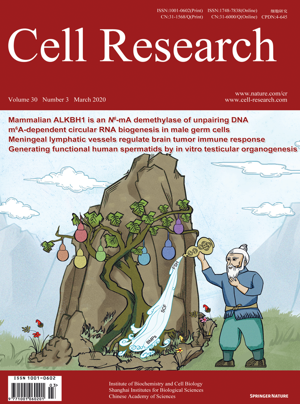
Volume 30, No 3, Mar 2020
ISSN: 1001-0602
EISSN: 1748-7838 2018
impact factor 17.848*
(Clarivate Analytics, 2019)
Volume 30 Issue 3, March 2020: 272-275
LETTERS TO THE EDITOR
Structural basis of nucleic acid recognition and 6mA demethylation by human ALKBH1
Li-Fei Tian 1,2, Yan-Ping Liu2, Lianqi Chen 2,3, Qun Tang2, Wei Wu1, Wei Sun2, Zhongzhou Chen 1 and Xiao-Xue Yan 2
1State Key Laboratory of Agrobiotechnology, College of Biological Sciences, China Agricultural University, 100193 Beijing, China; 2National Laboratory of Biomacromolecules, Chinese Academy of Sciences (CAS) Center for Excellence in Biomacromolecules, Institute of Biophysics, Chinese Academy of Sciences, 100101 Beijing, China and 3College of Life Sciences, University of Chinese Academy of Sciences, 100049 Beijing, China
These authors contributed equally: Li-Fei Tian, Yan-Ping Liu
Correspondence: Zhongzhou Chen (chenzhongzhou@cau.edu.cn) orXiao-Xue Yan (snow@ibp.ac.cn)
DNA N6-methyladenine (6mA) modification is common in prokaryotes1 and eukaryotes,2 involving in gene regulation, transposon, stem cell differentiation, and human tumors. At present, it has been confirmed that 6mA is ubiquitous in the human genome, and [G/C]AGG[C/T] is the most prominent motif for 6mA modification.3 Human ALKBH1 (hALKBH1), one of the nine human homologs of the AlkB family, is an Fe(II) and α-ketoglutarate (α-KG)-dependent dioxygenase and highly conserved in mammals. AlkB family proteins can repair damaged DNA/RNA or other lesions. hALKBH1 exhibits demethylation activity toward 6mA, and its abnormal expression has been found in many human cancers and developmental defects, such as tissue malformation and gender imbalance.3,4,5 DNA methyltransferase N6AMT1 and demethylase hALKBH1 mediate the methylation and demethylation of DNA 6mA in the human genome, respectively. The abnormal distribution of 6mA has been found in many cancers.3,4 Interestingly, hALKBH1 is also reported to have demethylation activity toward other four kinds of substrates, such as histone H2A,6 m3C on DNA and RNA,7 m5C or m1A on tRNA.8,9,10 Therefore, the molecular function of hALKBH1 is still controversial and the functional mechanism is unclear. In addition, the sequence identity between hALKBH1 and other solved structures is less than 19%, which hinders the understanding of action mechanism and the potential drug applications.
FULL TEXT | PDF
Browse 973


